Kurkuri bhindi is crispy fried okra and it makes for a spicy, totally delicious and impossibly moreish side or snack.
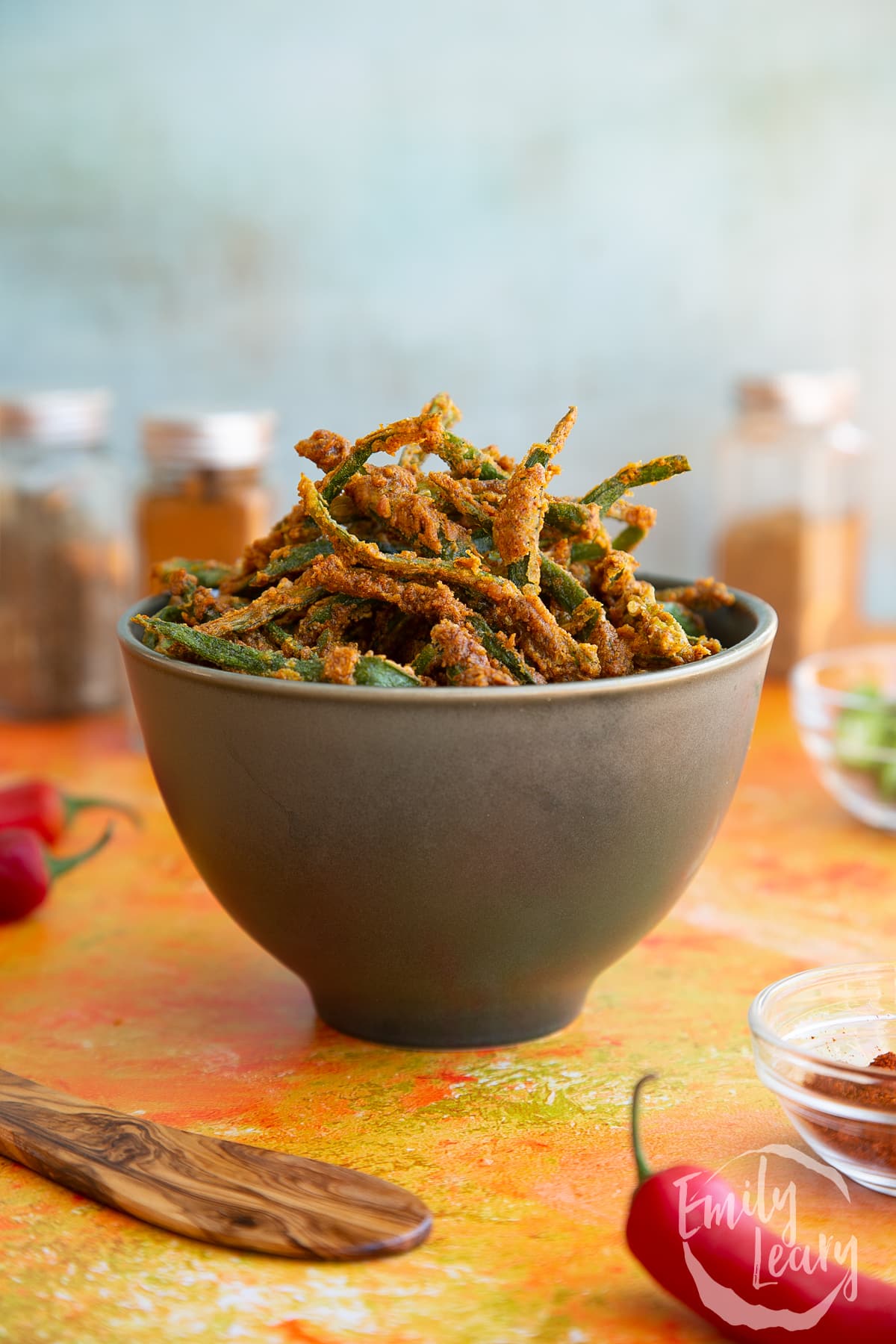
If you've never cooked with okra (also known as bhindi) before, never fear. This is a super simple recipe to get you started and you're sure to get great results.
The coating is made from gram flour spiced with turmeric, chilli and chaat masala and, once fried, they morph into beautifully golden treats you'll adore.
For the batter/coating, you'll need gram flour, also known as chickpea flour. This might not be an ingredient you immediately have to hand in your kitchen but it's well worth buying as you can use it in all sorts of recipes, such as pakoras and savoury pancakes.
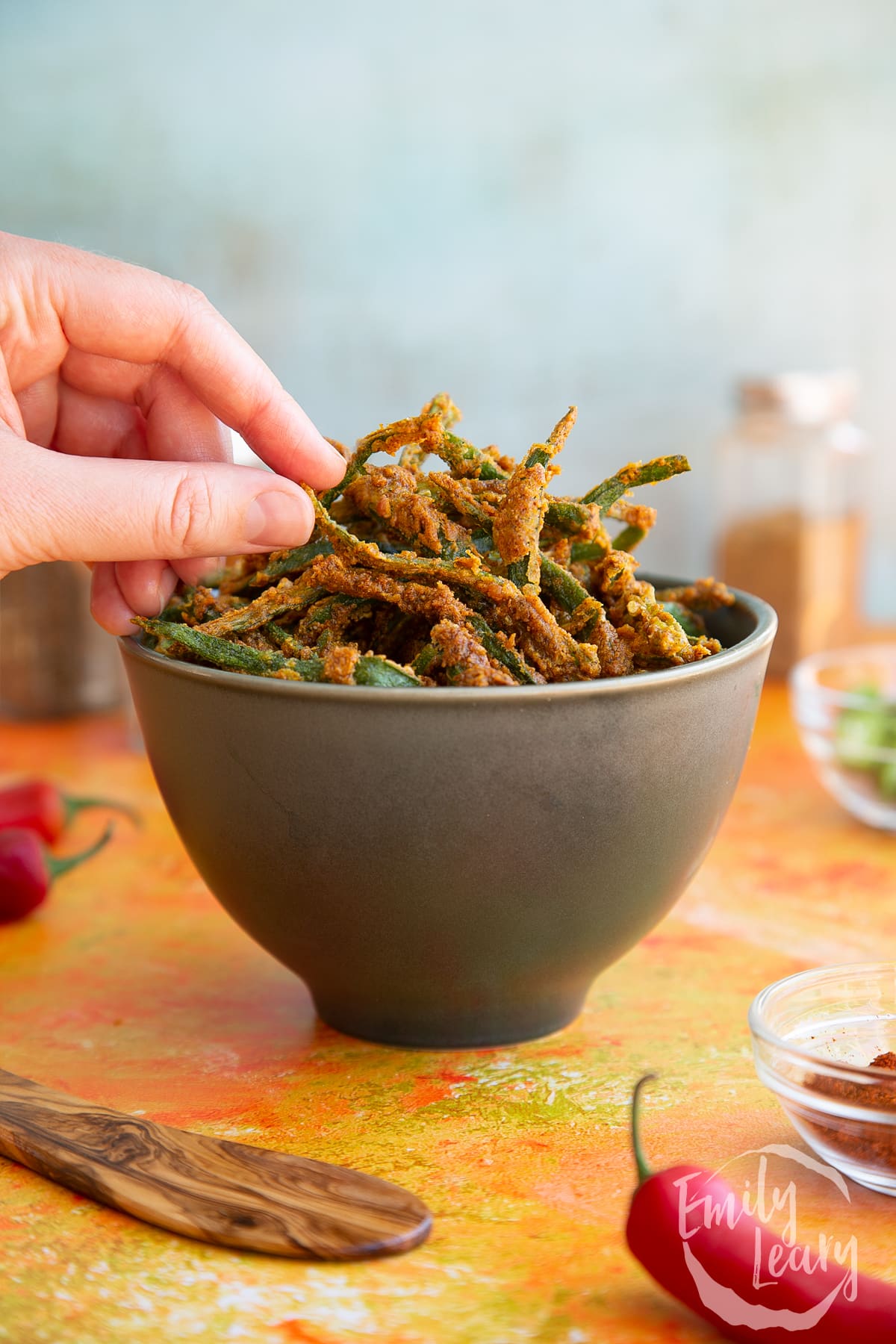
You should be able to find gram flour in your local supermarket. Try the 'world foods' section.
To the gram flour, you'll add turmeric, chilli, chaat masala and a pinch of salt and pepper. Now, if you can't get hold of chaat masala, you can use garam masala, which is more readily available in supermarkets.
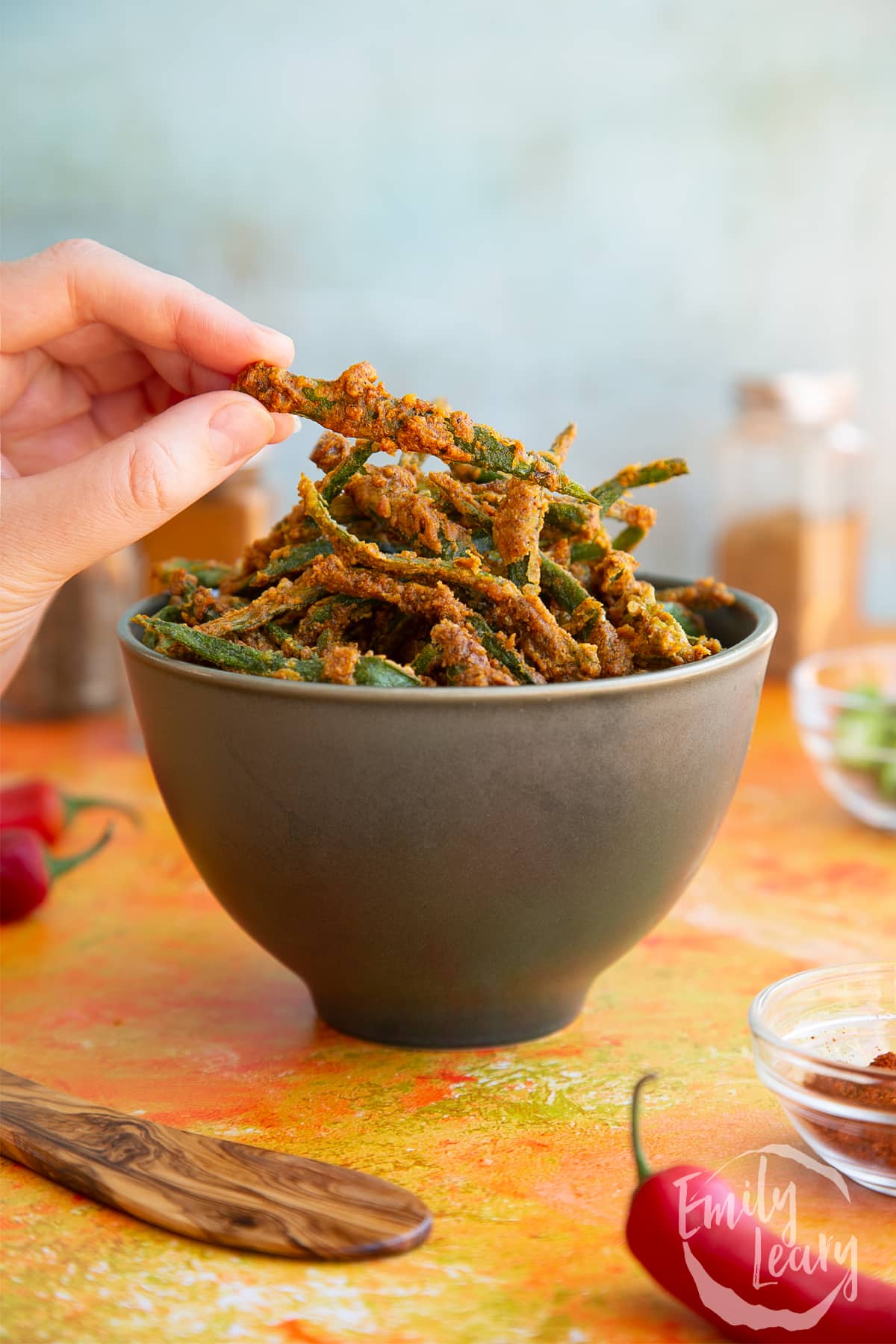
You'll then top and tail your okra, slice them lengthways into quarters and toss the whole bunch into your spiced gram flour. Once you add a touch of flour, the batter will clump a little and stick to your okra, which is just what we want!
Finally, you'll lower the coated okra into hot oil and fry for just a couple of minutes until crisp and golden. Delicious!
Here's the full recipe for kurkuri bhindi.
Ingredients
- 175 g okra topped and tailed, then sliced lengthwise into quarters
- 50 g gram flour (chickpea flour)
- ½ tsp ground turmeric
- 1 tsp chilli powder
- 2 tsp chaat masala or garam masala if you don't have any
- salt and black pepper
- vegetable oil to fry
Equipment
- Plate
- Deep fat fryer or suitable high-sided saucepan or suitable saucepan on the stove
Instructions
Put the gram flour, turmeric, chilli, chaat masala and a pinch of salt and pepper in a large bowl.
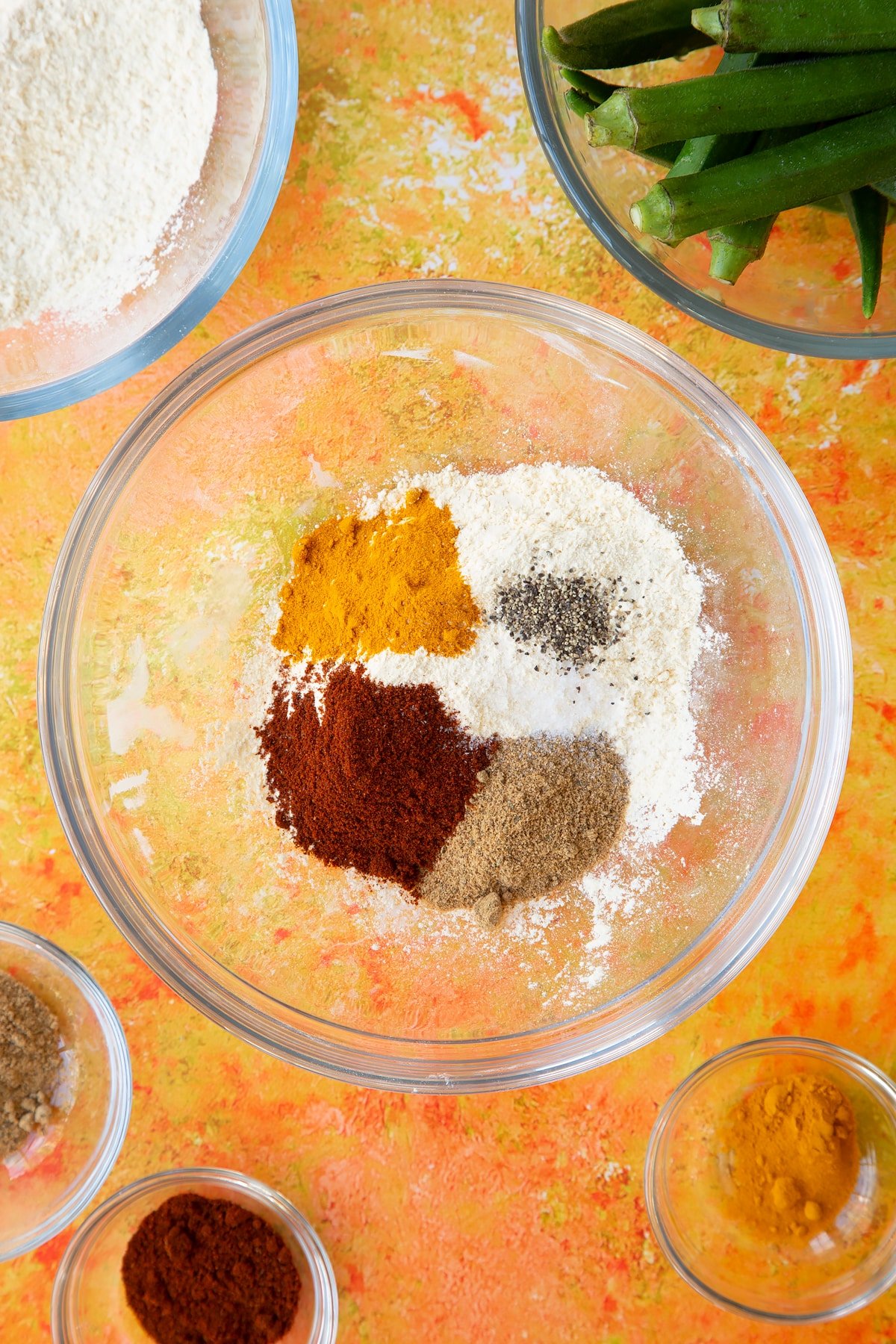
Whisk together to evenly combine.
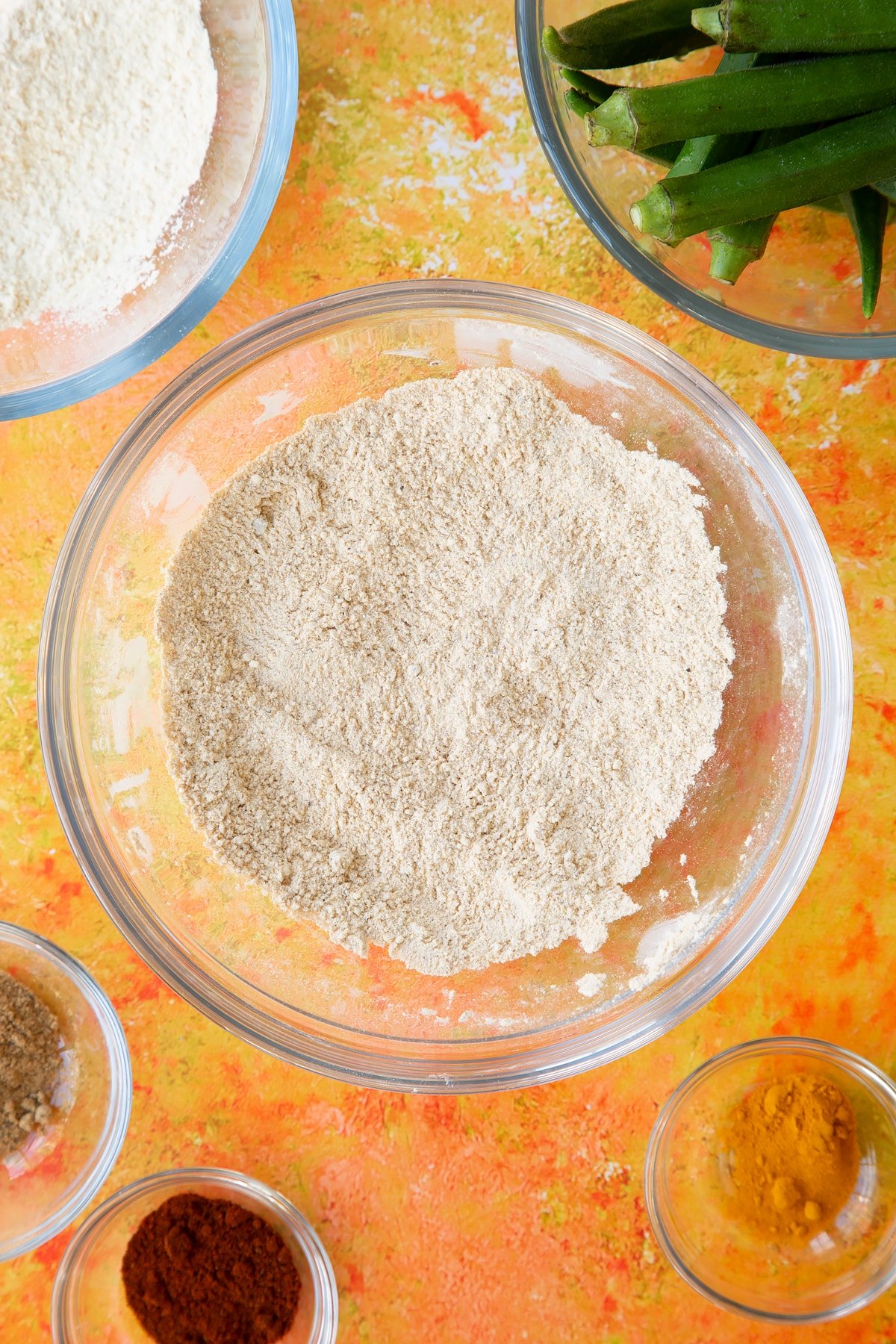
Add the okra.
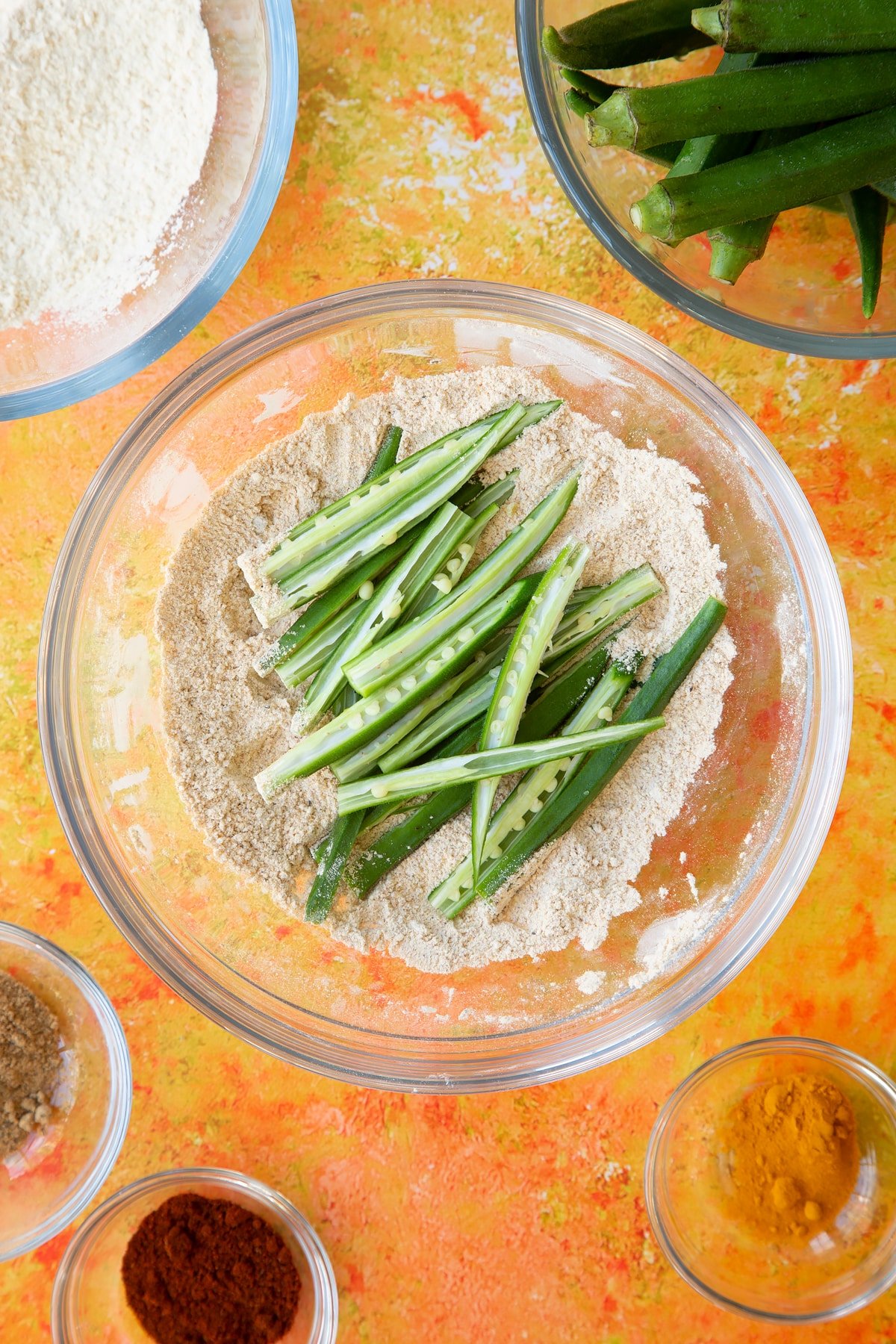
Toss until well coated.
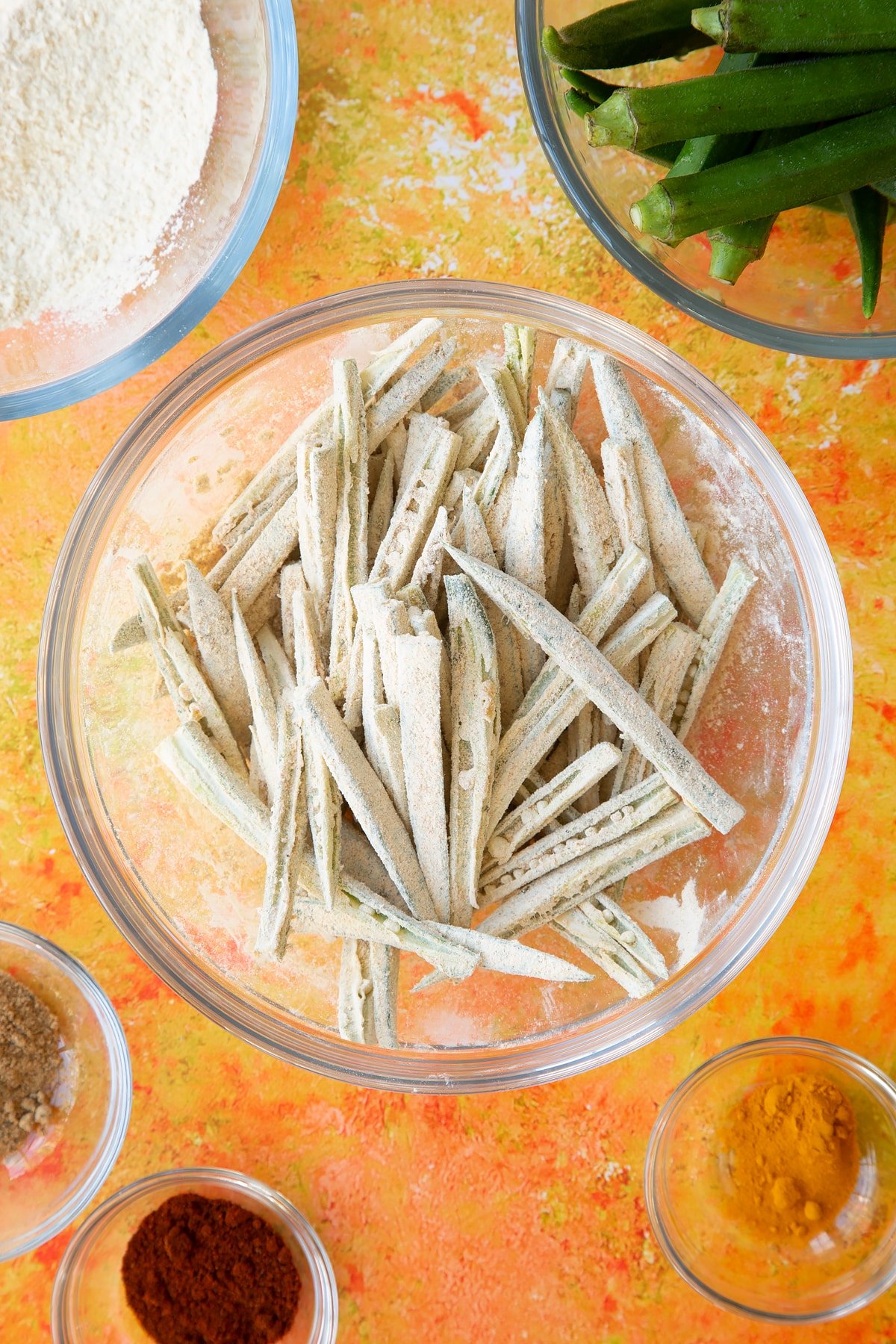
Stir in 1-2 tbsp of water to make the coating sticky. Leave to marinade while you heat the oil.
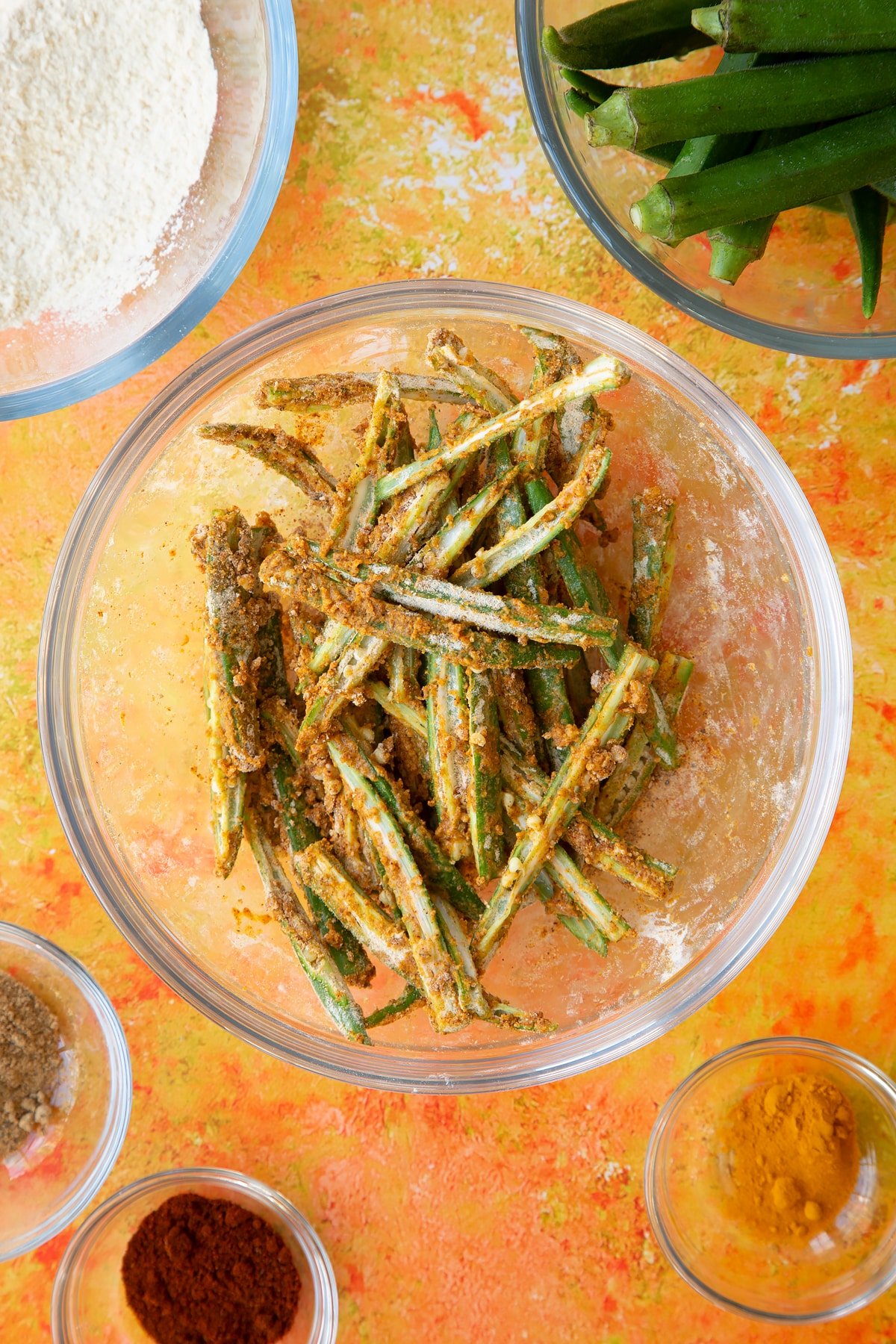
Fill a high sided pan with at least 3 inches of oil and heat to around 160C (310F) or until dropping a little of the coating into the water causes it to bubble immediately.
Working in batches so as not to overcrowd the pan, drop in some of the okra slices and fry for about 2.5-3 minutes until golden.
Lift out with a slotted spoon or wire straining spoon. Transfer to a plate lined with kitchen paper, season with a little salt and allow the oil to drain off.
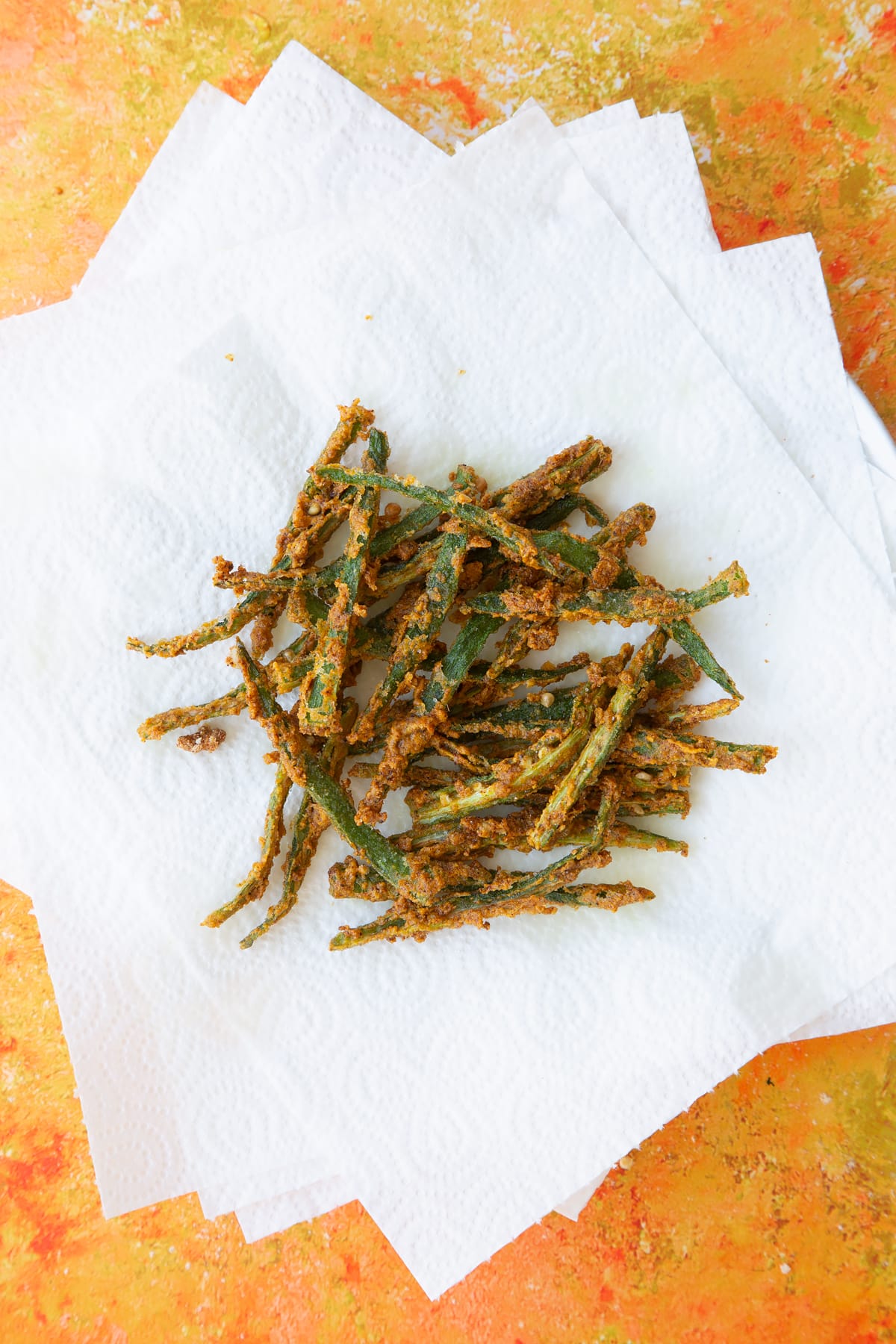
Once drained, you can keep the kurkuri bhindi warm by placing them on a baking sheet in a low oven, if you wish, while you fry the rest.
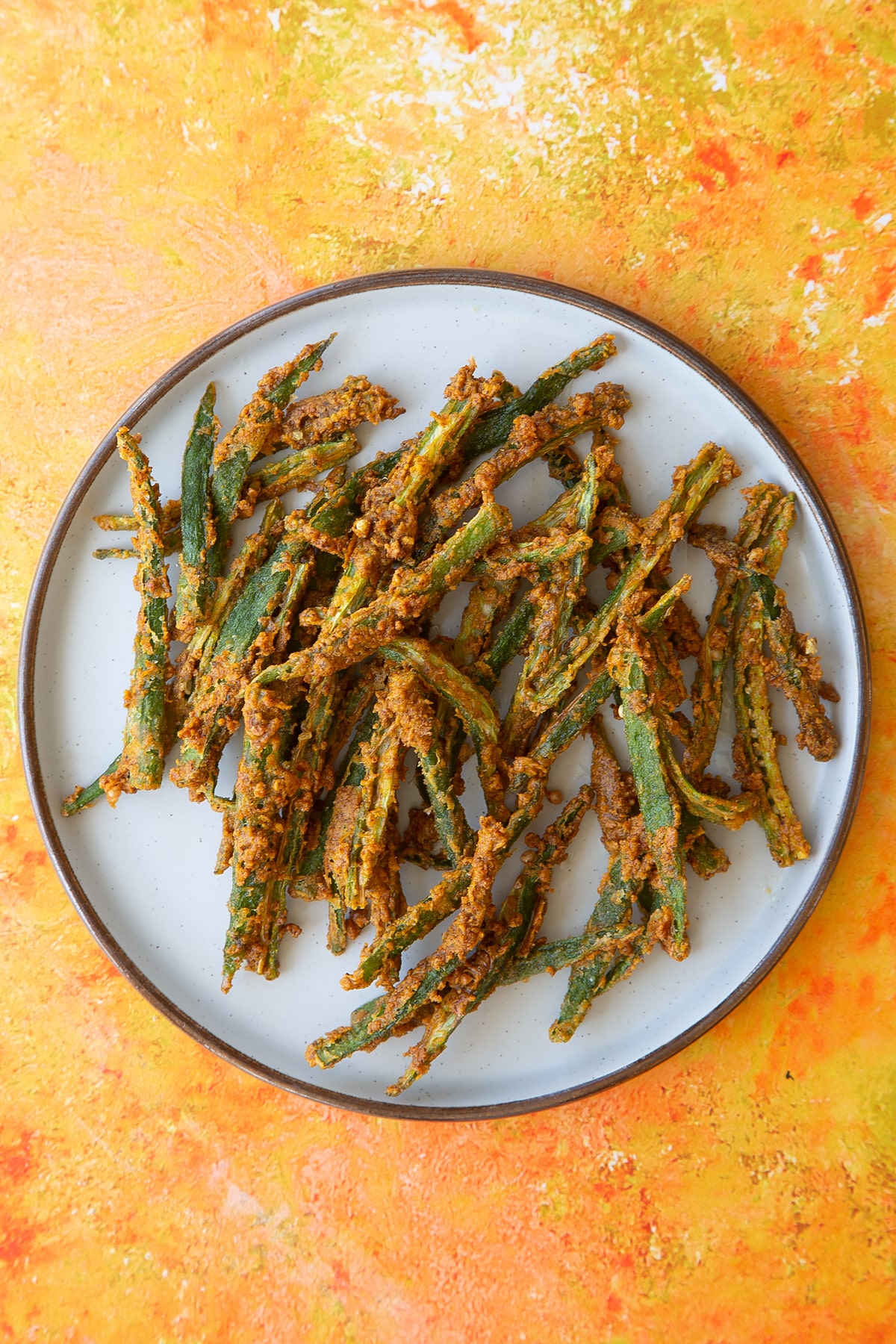
Serve hot and crispy.
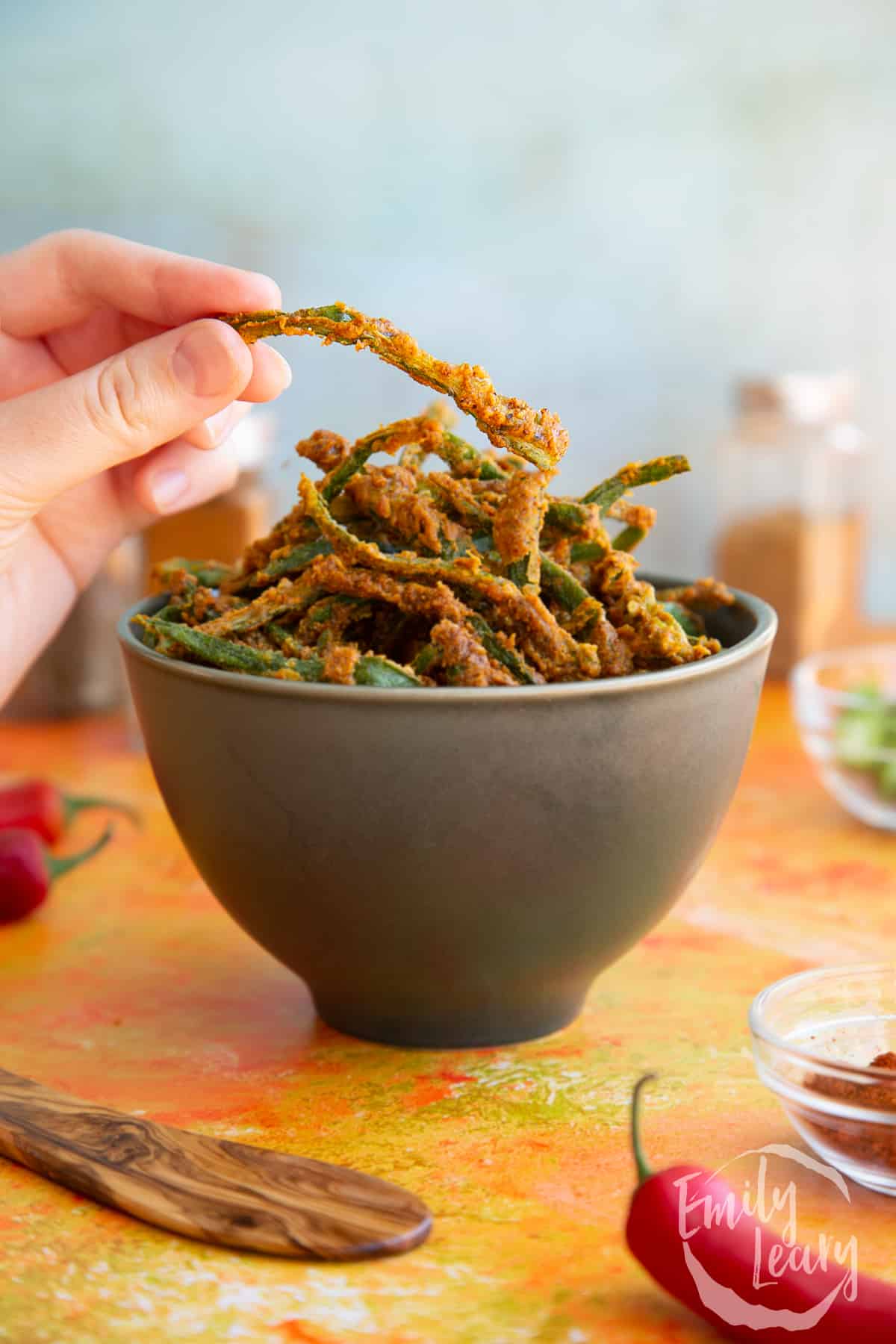
Enjoy!
Kurkuri bhindi
Keyword/term: Kurkuri bhindi
Pointers, tricks and troubleshooting tips for the perfect Kurkuri bhindi
What is Kurkuri bhindi?
Kurkuri bhindi means ‘okra fry’ in Hindi, and that’s just what it is - fried okra.
The okra is coated in a mixture made of spices, gram flour and a little water, then fried to create delicious Kurkuri bhindi.
While Kurkuri bhindi is a popular kind of street food in India, it has recently become popular in the UK, because of a restaurant chain called Dishoom. Dishoom makes a fried okra dish called Okra Fries. This recipe is similar, though the blend of spices is unique.
What is okra?
Okra (also known as ladies fingers), is a seed pod from an Okra plant. The okra plant can be found throughout Asia and Africa.
Okra is easy to grow and highly nutritious, so it has been a staple food for centuries, especially in India and Africa. As a result of the Atlantic slave trade, enslaved African people introduced the crop to North America and the Caribbean.
Okra pods have a fibrous texture and natural mucus which protects the seeds within. When prepared correctly, okra has a pleasant texture and tastes lovely with some salt.
However, if you cook okra without preparing it properly or without frying it before adding it to a curry, it can become overly slimy.
The best way to avoid slimy okra is to slice it and leave it to oxidise uncovered for 12 hours in the fridge. Or you can cook it in curries and stews with acidic foods like citrus or tomato to dissolve the slime.
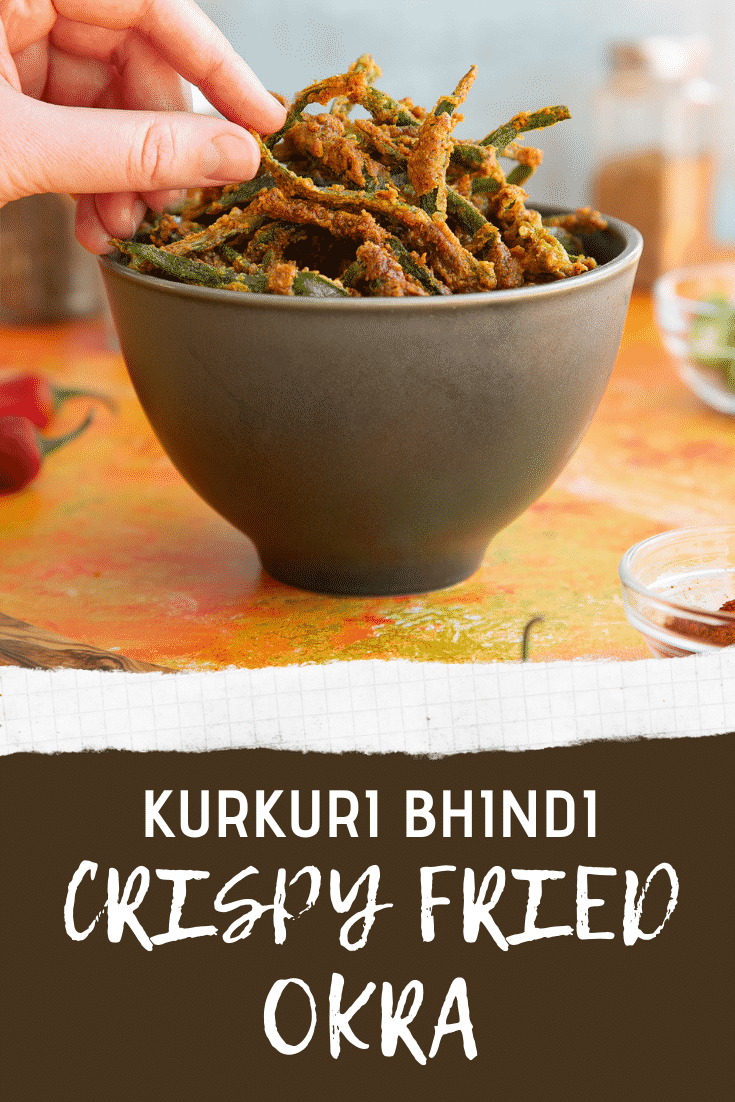
Is Kurkuri bhindi easy to make?
This recipe is super easy to make, but it is slightly dangerous as it uses hot oil.
So while there aren't any technical points to watch, you should take extra care when you’re frying your okra.
All you need to do is heat some oil in a pan. Then prepare and measure your ingredients, mix them and then fry the okra!
Will I need any special equipment to make Kurkuri bhindi?
Nope! The only things you’ll need for this recipe is a pan, a bowl, utensils, a knife, and some scales or measuring cups. So once you have your ingredients you should be away with no trouble!
There's always a complete list of suggested equipment on the recipe card below my recipes if you're in doubt. In addition, I always include links to example products, to show exactly what I used to make each recipe.
How do I stop my okra from turning slimy?
Deep frying your okra should remove the slime anyway, but if you’re very slime averse you could prepare okra by oxidising it.
You can do this by slicing okra and leaving it exposed to the air (under a cover) for a few hours. This causes the okra to dry out slightly and oxidise, reducing slime.
However, drying your okra may make it more difficult for the coating to stick.
Where do I buy okra?
If you live in the UK or Southern states of the US, you’ll probably find okra in the vegetable aisle of your local supermarket.
If you live in an area where Okra isn’t eaten so much, you’ll need to find an Indian, Chinese or Caribbean supermarket where you’re more likely to find okra sold.
Can I make Kurkuri bhindi with frozen okra?
I haven’t tried this recipe with frozen okra, but I don't think it would work well. First, frozen okra is usually sliced into tiny pieces, not lengthways, so it wouldn’t be the right shape.
Also, when okra freezes it usually becomes slimier as it defrosts, so it would probably become too wet to crisp in the oil while it’s cooking.
Is Kurkuri bhindi suitable for vegetarians?
Yep! There are only plant-based ingredients in this recipe so it’s completely safe for veggies!
Animal-derived products can be used to thicken, colour or flavour sweet and savoury food, so it sneaks into the most surprising ingredients! So always make sure that you double-check the labels of anything that you intend to serve with your recipe.
Is Kurkuri bhindi suitable for vegans?
Yes, this recipe is completely vegan as it only contains plant-based ingredients.
But don't forget to check anything extra that you intend to serve with your Kurkuri bhindi. Animal-derived ingredients can sneak into lots of sauces and dips without you realising it.
Is Kurkuri bhindi gluten-free?
Yes, this recipe uses gram flour instead of wheat flour. Gram flour is made from chickpeas, which are naturally gluten-free. So your Kurkuri bhindi will make a perfect snack for a gluten-free friend!
Double-check all of your ingredients labels to make sure that they are gluten-free. Don't forget to check anything extra that you intend to serve the recipe with.
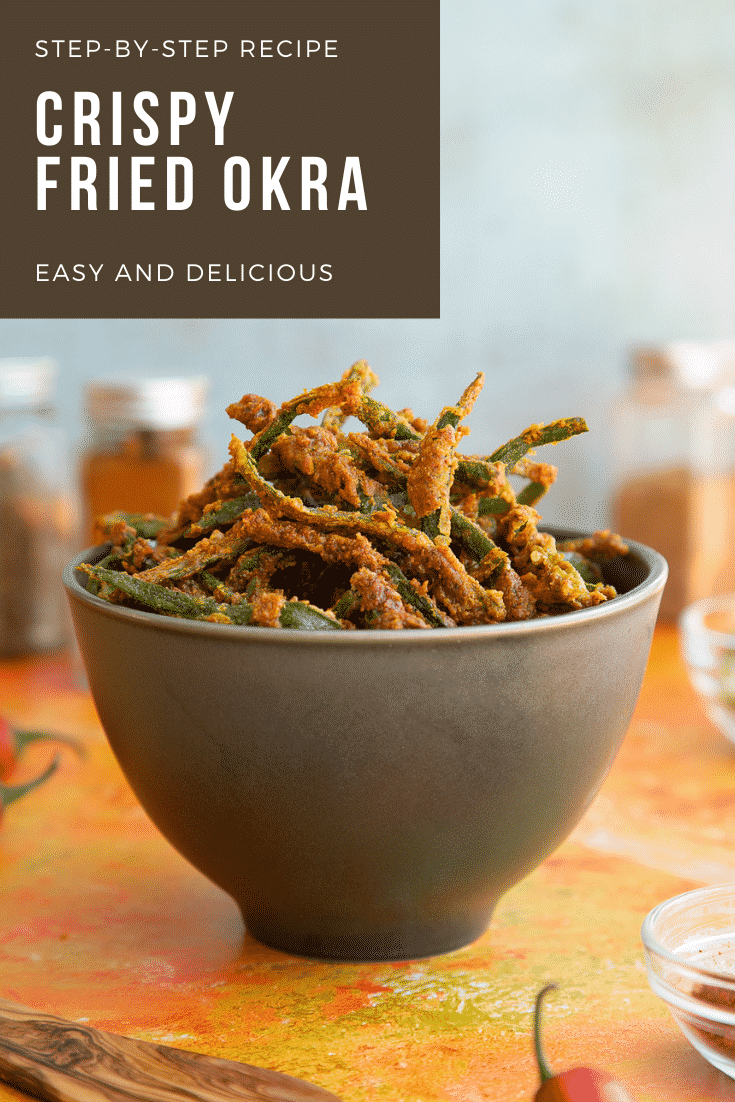
Is Kurkuri bhindi keto-friendly?
Sort of! Okra is low in carbohydrates and high in fibre. The flour used is gram or chickpea flour, which is better than wheat flour for a keto diet, but not completely keto-friendly.
However, the gram should be a very thin coating, so there will be negligible amounts in each portion!
Is Kurkuri bhindi healthy?
While okra is very good for you, this Kurkuri bhindi recipe is deep-fried, so it’s not super healthy.
Is Kurkuri bhindi safe to eat while pregnant?
Yes, feel free to treat a pregnant friend with this recipe. As there’s nothing in this recipe that would be of concern for a pregnant person.
Make sure that all of your ingredients are in good condition and that you prepare your Kurkuri bhindi safely and hygienically.
A Mummy Too does not offer medical advice. Please seek help from a medical professional if you need further information or have any concerns.
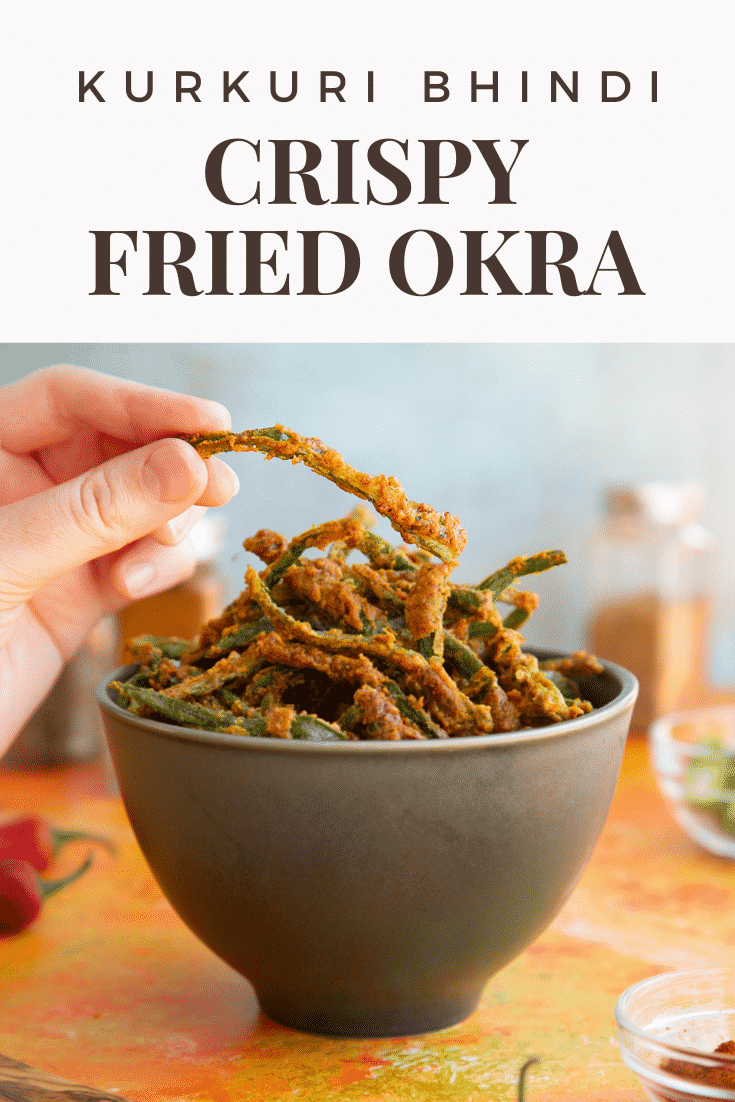
What goes well with Kurkuri bhindi?
Kurkuri bhindi is a perfect side for a summer BBQ or a curry. I think it goes well with a creamy raita or even tangy dipping sauces like Tamarind ketchup would be especially delicious,
Where did you get gram flour?
In the UK, we have many people of Indian and Pakistani heritage, so we have gram flour in most supermarkets. So if you’re in the UK, you’ll probably know where to find gram flour already (with wheat flour, or rice or sometimes on a ‘world foods’ aisle).
If you're in the US or Australia, you're more likely to find gram flour in health food stores or from Amazon.
Gram flour is super versatile, and a good alternative for gluten-free cooking. You can make many Indian dishes, like bhajis or dosas, so it’s worth having some in the cupboard anyway!
How should I store Kurkuri bhindi? How long will Kurkuri bhindi keep?
Kurkuri bhindi doesn’t store well, as it’s made from deep-fried okra which will become soggy over time. So it’s best to make Kurkuri bhindi when you want to eat them.
Plus, they’re so moreish you shouldn’t have any leftovers to keep anywhere!
Can I make Kurkuri bhindi ahead?Can I keep Kurkuri bhindi in the refrigerator?
This recipe is best enjoyed fresh. If you leave your Kurkuri bhindi in the fridge they will become soft and you won’t be able to reheat them without burning them.
Can I freeze Kurkuri bhindi?
Technically you can, but I wouldn’t advise it. You won't be able to re-fry your Kurkuri bhindi once it’s defrosted and you’ll most likely end up with some slimy, gross looking shrivelled cold bits of okra.
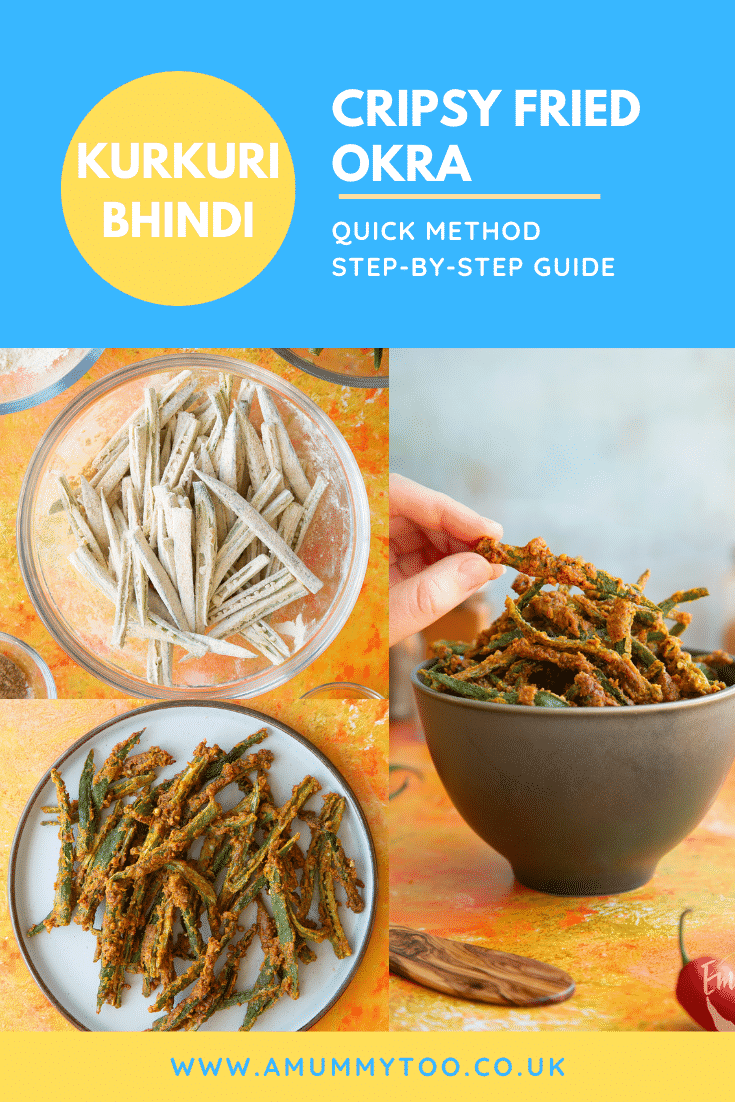
What is the best way to defrost Kurkuri bhindi?
Again, I wouldn’t advise freezing or defrosting this recipe as cold, defrosted Kurkuri bhindi will be deeply unpleasant to eat.
Can I make Kurkuri bhindi in a different quantity?
Sure! The best way to change the quantity is to use an online recipe calculator.
Or you can manually work out the quantities. For example, if you want to make double or half of the amount, just multiply or divide the ingredients by two.
Can I make Kurkuri bhindi in a stand mixer such as a KitchenAid or Kenwood Mixer?
There’s no need for a stand mixer in any stage of the recipe. So save yourself some washing up and mix your dry ingredients by hand.
Can I make Kurkuri bhindi with a food processor?
Erm, no. Stick to mixing your coating and okra by hand, unless you want an okra and chickpea paste!
How can I make sure my Kurkuri bhindi turns out perfectly?
This recipe is super simple, so to ensure your Kurkuri bhindi turns out perfectly there are only a couple of points to watch!
- Use young or shorter okra: Very long or thick okra tends to be tougher and more fibrous. So make sure that you choose okra which is around the size of your middle finger and has a green colour with little to no black dots.
- Don’t add too much water to the coating:
- Don’t overcrowd the pan: Cook your okra in batches to make it easier to regulate their cooking. If you have an overcrowded pan then it is more likely to splutter with hot oil. It's also more likely you’ll have inconsistently cooked okra.
- Don’t burn the okra!: Make sure you keep a close eye on the okra while you cook it. I’ve given an estimated time, but it’s best to use your eye with this recipe. If you’re unsure you can remove the okra to test them and return them to the pan if they aren’t ready.
- Drain your okra: Place your cooked Kurkuri bhindi on a double layer of kitchen roll to absorb any excess oil.
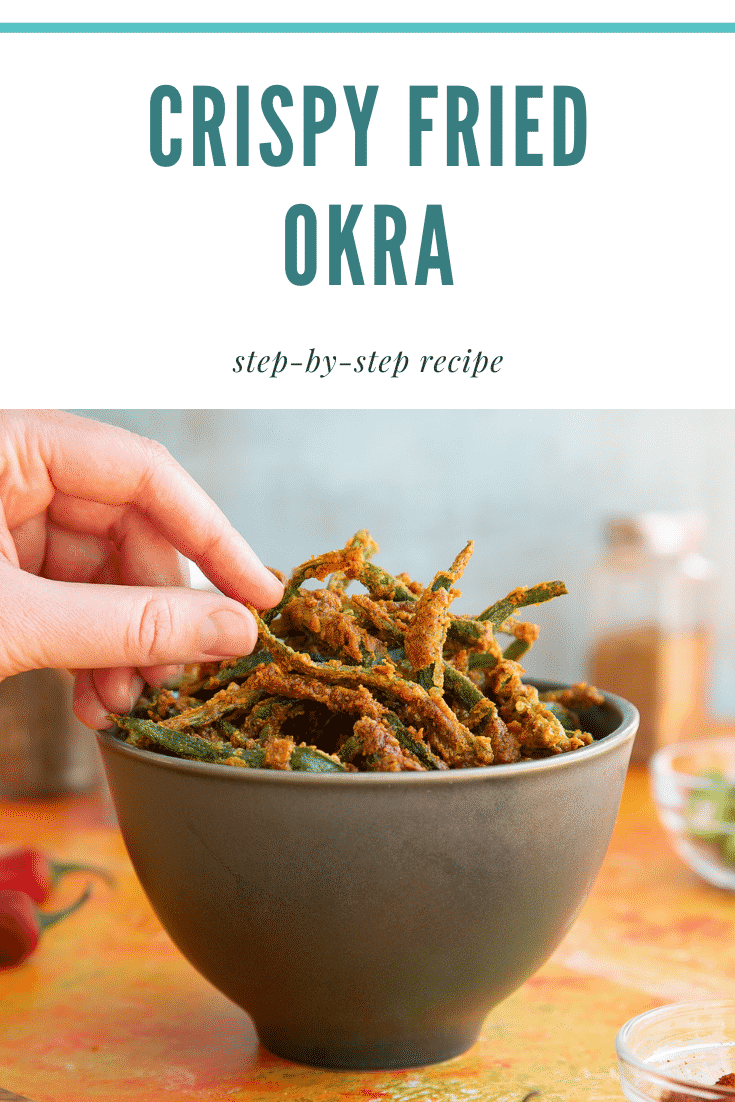
Why did my Kurkuri bhindi turn out slimy?
Frying your okra should evaporate any slime produced by the okra, so if your okra is still slimy then it sounds like they’re undercooked. If your Kurkuri bhindi isn’t burned or looks barely cooked, return them to the oil and see if that helps.
Why didn’t my gram flour stick to the okra?
If your gram flour didn't stick to the okra, then it might be because you forgot to add the water, or you added far too much water.
You only need to add 1-2 tablespoons of water for the coating to stick to the okra.
If you forget the water, the flour and spices will just roll off the okra, if you add too much water you’ll end up with a runny batter that doesn’t stick either.
How can I add/change the flavours in my Kurkuri bhindi?
Masala means a blend of spices, so chaat masala and garam masala contains different blends of spices and flavours. If you want to change the flavours in your Kurkuri bhindi, the most obvious step would be to use a different garam or blend your own mix.
For example, chaat masala usually contains sour ingredients like pomegranate or amchor (dried green mango powder). These ingredients give chaat masala and Kurkuri bhindi a slightly tangy flavour. If you don’t like this, you could just use garam masala or a blend of the other ingredients in Chaat masala.
Chaat masala also contains black salt, which has a natural amount of sulphur giving it a slightly egg-like taste. Some people love it, others hate it. If you love that flavour and want more, you could add ¼ a teaspoon of Asafetida - another Indian spice which has a garlicky, sulphur flavour to it.
You could also toss your cooked Kurkuri bhindi in some salt and pepper or another seasoning (which doesn't need cooking) to give it an extra kick.
There’s a fine art to getting spice levels balanced, so it might be a good idea to read into it further. The Prashad cookbook from the Michelin star Indian restaurant, Prashad, has some great information and guides on how to balance your spices for the best results.
Or the Dishoom cookbook is another good source for spice techniques.
You shouldn't use wet ingredients to flavour your Kurkuri bhindi or it will negatively affect the consistency of the coating and possibly cause the okra to splatter in the oil dangerously.
Print this kurkuri bhindi recipe
Kurkuri Bhindi Recipe
Ingredients
- 175 g okra topped and tailed, then sliced lengthwise into quarters
- 50 g gram flour (chickpea flour)
- ½ tsp ground turmeric
- 1 tsp chilli powder
- 2 tsp chaat masala or garam masala if you don't have any
- salt and black pepper
- vegetable oil to fry
Equipment
- Plate
- Deep fat fryer or suitable high-sided saucepan or suitable saucepan on the stove
Instructions
- Put the gram flour, turmeric, chilli, chaat masala and a pinch of salt and pepper in a large bowl. Whisk together to evenly combine.
- Add the okra and toss until well coated.
- Stir in 1-2 tbsp of water to make the coating sticky. Leave to marinade while you heat the oil.
- Fill a high sided pan with at least 3 inches of oil and heat to around 160C (310F) or until dropping a little of the coating into the water causes it to bubble immediately.
- Working in batches so as not to overcrowd the pan, drop in some of the okra slices and fry for about 2.5-3 minutes until golden.
- Lift out with a slotted spoon or wire straining spoon. Transfer to a plate lined with kitchen paper, season with a little salt and allow the oil to drain off.
- Once drained, you can keep the kurkuri bhindi warm by placing them on a baking sheet in a low oven, if you wish, while you fry the rest.
- Serve hot and crispy.
Video
Nutrition
Pin this kurkuri bhindi recipe
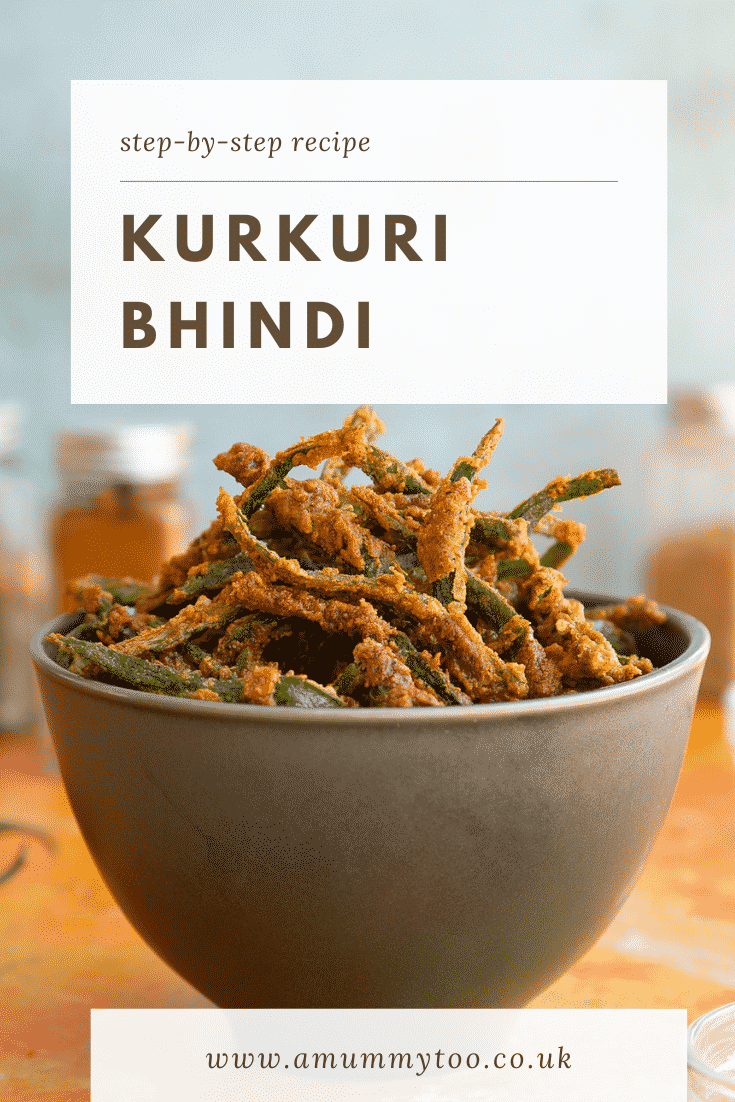
More vegetarian recipes to try
Have you got my book?

'This is a great kids cookery book. Emily is a star' - Simon Rimmer
'The book I'd like to force into any mother's kitchen' - Prue Leith
"A fab book with a plan." - Jane Devonshire, 2016 Masterchef UK winner
'Emily has managed to combine her mummy knowledge and passion for food to make a truly helpful and brilliant cookbook' - Priya Tew, RD, BSc (Hons), Msc
Get Your Kids to Eat Anything is an achievable 'how to' for parents in the battle to overcome picky eating and 'make new the norm'. Emily Leary's unique 5-phase programme looks at the issue of 'fussy eating' in a holistic way that links imagination with food, and which situates parents alongside - not in opposition to - their children.
.

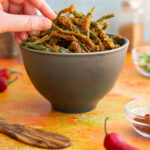

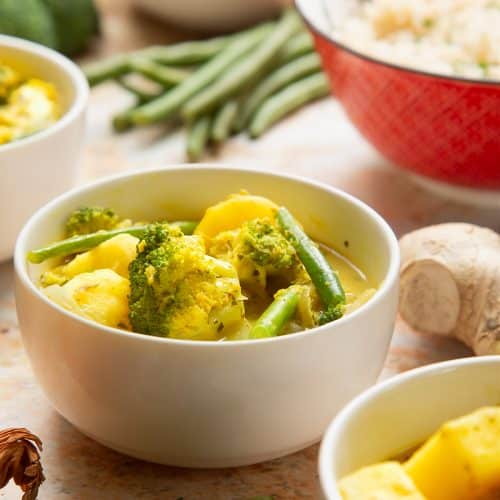

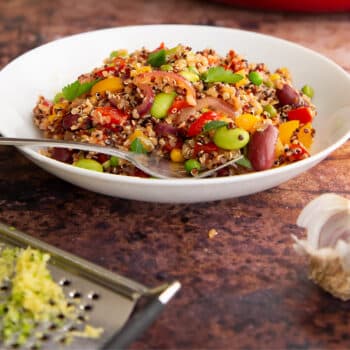
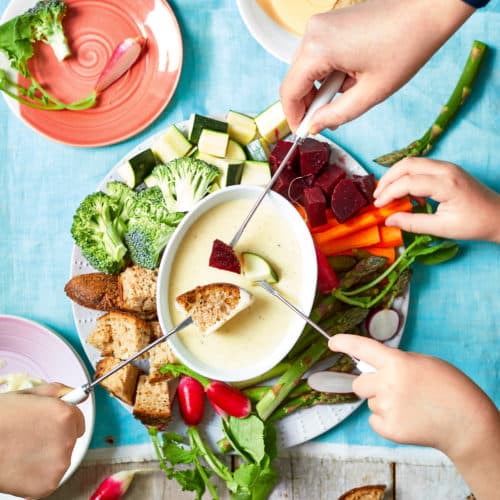
Leave a Reply